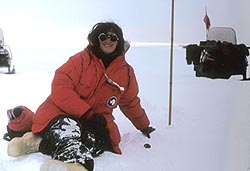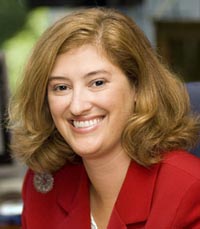Feature
Born to Explore
06.08.06
| Who Are NASA's Space Science Explorers? Who are NASA's Space Science Explorers? The scientist studying black holes in distant galaxies. And the engineer working on robotic machines bound for space. But also the teacher explaining the mysteries of the cosmos. And the student wondering if there is life beyond Earth. All of these people are Space Science Explorers. They are all linked by their quest to explore our solar system and universe. This monthly series will introduce you to NASA Space Science Explorers, young and old, with many backgrounds and interests. Nominate a Space Science Explorer! Tell us about the Space Science Explorers you know. We're looking for students, teachers, scientists and others who have a connection to NASA, whether they work for the agency or are involved in a NASA-supported mission or program. Send your nominations to Dan Stillman: dan_stillman@strategies.org. |
Laurie Leshin loves to explore. As a child, she was always curious about the world around her. Since then, she has explored the universe as a student, a teacher and now a scientist. The word "exploration" is even part of her job title. Leshin works at the NASA Goddard Space Flight Center. She is the director of sciences and exploration there.

|
The universe is full of things to explore. What in particular is Leshin hoping to find? Why is she so interested in water and life in the solar system? What steps can you take to become an explorer just like her?
Space Science Explorers chatted with Leshin about these and other questions.
Space Science Explorers: How did you first get interested in science?
Leshin: I grew up enjoying the outdoors and loved rocks and stars. My parents always encouraged me to do whatever I was interested in. I also had some great science teachers in high school and college. They convinced me that I wanted to study science.
SSE: How did you get to where you are now?
Leshin: During my college years, I worked for a summer at the Lunar and Planetary Institute in Houston. There are a lot of scientists there studying the solar system. That got me hooked on space science research. I studied hard and went on to become a professor at Arizona State University. There, I got to teach great students. I also got to study meteorites. They can tell us a lot about the origin of the solar system and the planets.
In 2004, I was lucky enough to be asked to help guide NASA. The president had just announced a new plan for NASA, called the Vision for Space Exploration. NASA was looking for advice on how to achieve the vision. After that, I really wanted to be part of the team that would carry out missions related to this vision. So, I was thrilled when I got the chance to come and lead the science and exploration division at Goddard. I think it's the largest organization of Earth and space scientists in the world.
SSE: What is your typical day like in your current job?
Leshin: We are working on so many projects. These range from giant space telescopes to satellites that track hurricanes. As a result, I talk to many different people every day. I make sure that all of our programs are moving forward. I also try to get new programs started. The exciting thing is the wide range of topics I deal with on any given day. In the morning, I may be talking about a mission to the moon. At midday, I may be talking about the latest research on pollution. Then, in the afternoon, I may be talking about laser or X-ray technology.

|
SSE: What NASA missions have you worked on in the past?
Leshin: I was on the science team for the Mars Polar Lander. Unfortunately, it crashed when it arrived at Mars in 1999. I was on live TV when it crashed -- not fun. The next few days were incredibly difficult. We had to figure out what happened and whether the mission could be recovered. Missions involve hundreds of people, and it's hard to lose something that you've put so much work into. But I was also amazed at how quickly I got involved with another mission, and then another. Once you get that close to exploring another planet, it makes you want to do it even more.
Now I'm on the team for the next big Mars rover, the Mars Science Laboratory. Launch is planned for 2009. The MSL will explore even more of the planet than the Spirit and Opportunity rovers that are there now. It will carry the most advanced instruments we've ever sent to the surface of another world.
SSE: What future NASA missions are you most excited about?
Leshin: I'm very excited about two missions we are working hard on at Goddard. These are the Lunar Reconnaissance Orbiter and the James Webb Space Telescope.
The JWST is scheduled to launch in 2013. It will look farther into the universe than any telescope ever has. It will see back to the very first galaxies, and help us understand how we got here.
SSE: Why are scientists so interested in finding water in the solar system?
Leshin: Liquid water is a necessary ingredient for life. So, finding evidence of it on a planet means that there could be, or could have been, life on that planet. Can you imagine a discovery more exciting than that?
SSE: Besides Earth, what is your favorite planet and why?
Leshin: Mars, definitely. Mars is so much like Earth in some ways, and yet just different enough to make it so interesting. It has volcanoes, ice caps, canyons and dried-up river beds. And we have the ability to find out whether there is, or was, life on Mars. I can't wait to find out the answer.
SSE: What advice do you have for students who are thinking about a career in science?
Leshin: Go for it! Nothing stands in your way. The exploration you get to do every day as a scientist is one of the coolest things you can do. Every day, you are trying to do things that have never been done before. If you even think you want to be a scientist, make sure you take math and science courses. Visit science museums, too. Also, try to meet scientists and talk to them about what they do.